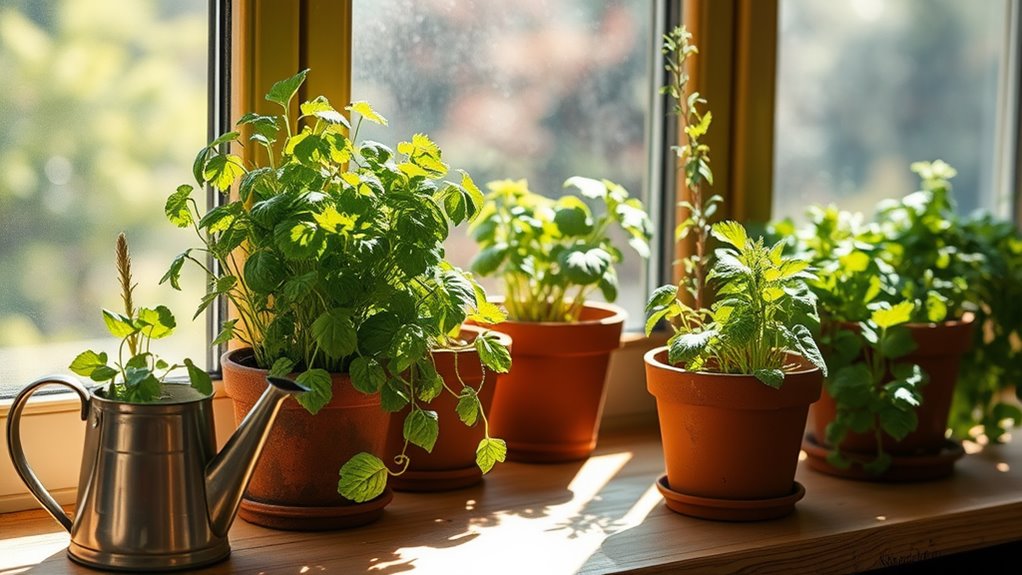Here’s How I Started With Indoor Herb Gardens (Even as a Beginner)
Did you know that growing your own herbs indoors can not only enhance your meals but also improve your indoor air quality? If you’ve ever considered starting an indoor herb garden, you might be surprised at how simple it is, even for beginners. From choosing the right herbs to understanding their light and water needs, there are key steps that can lead you to success. Let’s explore how to transform your kitchen into a thriving herb haven.
Choosing the Right Herbs for Your Indoor Garden
What herbs should you choose for your indoor garden?
Start with easy-to-grow options like basil, thyme, and mint.
Begin your indoor garden journey with simple herbs like basil, thyme, and mint for flavorful success.
These herbs thrive in smaller spaces and offer vibrant flavors for your meals.
Basil loves warmth and bright light, while thyme requires less water, making it perfect for beginners.
Mint, with its refreshing scent, can flourish in a variety of conditions, adding an aromatic touch to your indoor herb gardens.
Consider your culinary preferences too; if you enjoy Italian dishes, basil is a must!
Choose herbs that inspire you, and watch your indoor garden flourish with life and flavor. Additionally, many herbs can be grown indoors with proper lighting, allowing you to enjoy fresh flavors year-round.
Selecting the Perfect Containers and Soil
Selecting the Perfect Containers and Soil
Choosing the right containers and soil is crucial for your indoor herb garden’s success.
Opt for pots with drainage holes to prevent waterlogging, which can harm your herbs.
Terracotta or ceramic containers not only look great but also allow for breathability.
As for soil, select a well-draining potting mix, ideally one formulated for herbs or vegetables.
This ensures your plants receive adequate nutrients while maintaining moisture without becoming soggy.
Don’t forget to consider the size of your containers; larger pots can hold more soil, which helps retain moisture and supports healthy growth.
Additionally, using well-draining potting mix will significantly enhance the health and productivity of your herbs.
Happy planting!
Understanding Light Requirements for Indoor Herbs
After selecting the right containers and soil, the next key element to consider is the light your herbs will need to thrive. Different herbs have unique light requirements, so understanding these can make a significant difference in their growth. Generally, most herbs prefer 6-8 hours of bright, indirect sunlight daily. Additionally, using a unique trick like rotating your plants can also lead to healthier growth and a more abundant harvest.
| Herb | Light Requirement | Best Position |
|————–|———————–|———————–|
| Basil | Full sun | South-facing window |
| Mint | Partial shade | East-facing window |
| Parsley | Bright, indirect light | Near a bright window |
Keep these tips in mind, and your indoor herb garden will flourish!
Watering and Maintenance Tips for Healthy Growth
Watering is the lifeblood of your indoor herb garden, and getting it right can make all the difference between thriving plants and wilting leaves.
Watering is essential for your indoor herb garden, determining the difference between vibrant growth and drooping leaves.
To ensure healthy growth, follow these maintenance tips:
-
Check moisture levels by sticking your finger in the soil.
-
Water thoroughly until it drains from the bottom.
-
Use room temperature water to avoid shocking the roots.
-
Mist your herbs to maintain humidity, especially in dry environments.
-
Rotate your plants regularly for even light distribution.
Additionally, it’s important to choose the right light conditions to support your herbs’ growth.
With these simple steps, you’ll foster a vibrant indoor herb garden that flourishes and brings flavor to your kitchen!
Harvesting and Using Your Fresh Herbs
Once your indoor herb garden is thriving, it’s time to enjoy the fruits of your labor by harvesting and using those fresh herbs in your cooking.
Snip the leaves or stems with clean scissors, taking care not to damage the plant.
Use herbs like basil, cilantro, or parsley to elevate your dishes—add them to salads, sauces, or even as a garnish.
Experiment with different combinations to discover your favorite flavors.
Remember, fresh herbs can also be frozen or dried for later use.
Incorporating real food meals into your diet can enhance the flavor and nutritional value of your dishes.
Enjoy the vibrant taste and aroma, and let your culinary creativity flourish with every harvest!

